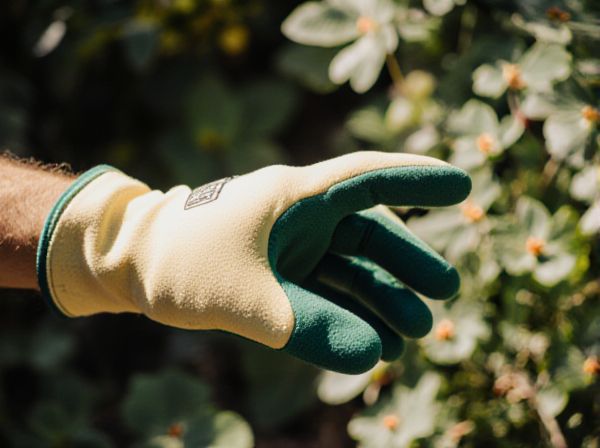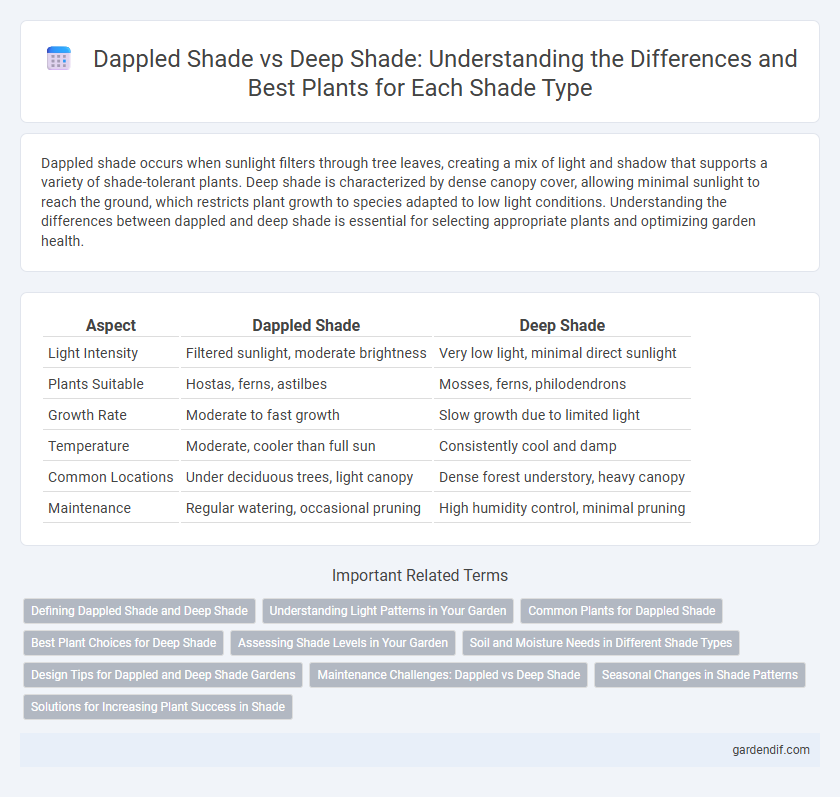
Dappled Shade vs Deep Shade Illustration
Dappled shade occurs when sunlight filters through tree leaves, creating a mix of light and shadow that supports a variety of shade-tolerant plants. Deep shade is characterized by dense canopy cover, allowing minimal sunlight to reach the ground, which restricts plant growth to species adapted to low light conditions. Understanding the differences between dappled and deep shade is essential for selecting appropriate plants and optimizing garden health.
Table of Comparison
| Aspect | Dappled Shade | Deep Shade |
|---|---|---|
| Light Intensity | Filtered sunlight, moderate brightness | Very low light, minimal direct sunlight |
| Plants Suitable | Hostas, ferns, astilbes | Mosses, ferns, philodendrons |
| Growth Rate | Moderate to fast growth | Slow growth due to limited light |
| Temperature | Moderate, cooler than full sun | Consistently cool and damp |
| Common Locations | Under deciduous trees, light canopy | Dense forest understory, heavy canopy |
| Maintenance | Regular watering, occasional pruning | High humidity control, minimal pruning |
Defining Dappled Shade and Deep Shade
Dappled shade refers to areas where sunlight filters through the leaves of trees, creating a patchwork of light and shadow that supports a variety of shade-tolerant plants. Deep shade, on the other hand, is characterized by very limited light availability, often found under dense tree canopies or structures, restricting plant growth to only the most shade-adapted species. Understanding the difference between dappled shade and deep shade is crucial for selecting appropriate vegetation and managing garden microclimates effectively.
Understanding Light Patterns in Your Garden
Dappled shade occurs when sunlight filters through tree leaves, creating a mosaic of light and shadow ideal for shade-tolerant plants that require intermittent sunlight. Deep shade is characterized by minimal direct sunlight, often found under dense canopies, demanding plants with high shade tolerance and low light requirements. Understanding these light patterns helps gardeners select appropriate plants and optimize growth by matching species to the specific intensity and duration of shade in their garden.
Common Plants for Dappled Shade
Dappled shade, characterized by filtered sunlight through tree branches, supports a wide variety of common plants including hostas, ferns, astilbes, and coral bells that thrive in partial light conditions. These plants flourish in environments where they receive intermittent sun, enhancing foliage color and flower production. Understanding the light requirements of dappled shade plants is essential for creating vibrant, healthy garden spaces beneath deciduous trees or light canopies.
Best Plant Choices for Deep Shade
Best plant choices for deep shade include hostas, ferns, and hellebores, which thrive in low-light conditions and maintain lush foliage without direct sunlight. Shade-tolerant groundcovers like sweet woodruff and ajuga are effective for covering deep shade areas while preventing soil erosion. Additionally, woodland perennials such as astilbe and bleeding heart offer vibrant blooms that flourish in dense shade environments.
Assessing Shade Levels in Your Garden
Dappled shade occurs when sunlight filters through tree leaves, creating a pattern of light and shade, ideal for plants that need partial sun exposure. Deep shade, characterized by minimal direct sunlight often found under dense tree canopies or structures, requires shade-tolerant plants adapted to low-light conditions. Assessing shade levels involves observing sunlight duration and intensity throughout the day, noting areas with leaf movement and filtering for dappled conditions versus consistently dark zones indicating deep shade.
Soil and Moisture Needs in Different Shade Types
Dappled shade areas receive filtered sunlight, promoting soil that stays moderately moist and well-drained, ideal for plants requiring balanced hydration. Deep shade zones often have cooler, consistently damp soils due to limited sunlight, necessitating moisture-loving plants adapted to lower evaporation rates. Understanding these soil and moisture dynamics is crucial for selecting appropriate vegetation resilient to each shade type.
Design Tips for Dappled and Deep Shade Gardens
Dappled shade gardens thrive with plants like hostas, ferns, and astilbes that tolerate intermittent sunlight, creating a dynamic interplay of light and shadow. For deep shade areas, emphasize foliage variety and texture using plants such as Japanese forest grass, hellebores, and foamflower to maintain visual interest despite low light. Incorporate layered planting and contrasting leaf colors to enhance depth and balance in both dappled and deep shade garden designs.
Maintenance Challenges: Dappled vs Deep Shade
Dappled shade creates a unique maintenance challenge as it allows intermittent sunlight, promoting varied plant growth that requires regular pruning and selective watering to prevent overcrowding and disease. Deep shade complicates upkeep due to limited light, necessitating shade-tolerant plant species and more frequent soil amendment to enhance nutrient uptake and moisture retention. Both conditions demand tailored strategies for pest control and soil management to sustain healthy plant development.
Seasonal Changes in Shade Patterns
Dappled shade occurs when sunlight filters through the canopy, creating a dynamic pattern of light and shadow that shifts with the angle of the sun and seasonal leaf density. In contrast, deep shade features minimal light penetration due to dense foliage or permanent structures, resulting in consistently low light levels throughout the year. Seasonal changes intensify the contrast as deciduous trees in dappled shade zones lose leaves in winter, increasing light exposure, whereas deep shade remains largely unaffected by seasonal leaf drop.
Solutions for Increasing Plant Success in Shade
Dappled shade allows filtered sunlight, making it ideal for shade-tolerant plants like hostas and ferns, which thrive with moderate light and consistent moisture. Deep shade requires selecting highly shade-adapted species such as mosses or certain evergreens, paired with soil amendments to improve nutrient availability and drainage. Implementing mulching techniques and targeted irrigation ensures optimal root health and moisture retention, significantly boosting plant success in various shaded environments.
Dappled Shade vs Deep Shade Infographic

 gardendif.com
gardendif.com